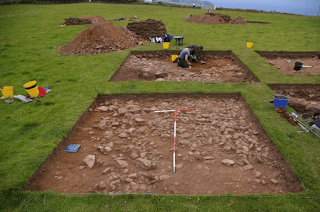3.1: The Archaeological Record
The archaeological record is a core concept of archaeology in the English-speaking world, yet one that is difficult to define adequately. Archaeology is in effect the academic discipline concerned with documenting and interpreting the archaeological record. Inasmuch as the historical record is the body of written and other documentary material that forms the evidence for the creation of the historiographic interpretation of the past, the archaeological record is the body of physical evidence usable to create the archaeological interpretation of the past. Archaeological method and theory supply the normative means to allow interpretations to be made and assessed.
The notion of 'archaeological record' is a cover-all concept for a set of material or physical traces that can be used as a basis for archaeological inference. As such, depending on the subject being investigated, it could range in size from, for example, a single hunter-gatherer's hearth and discrete associated tool scatter in an otherwise barren blowout in a sand dune, to entire landscapes [***] or spreads of material created by specific processes (a layer of alluvium in a river valley caused by Neolithic soil erosion). It can consist of evidence relating to the earliest human societies as well as contemporary ones.
Components of the archaeological record include built structures, landscape features, spatial data, soil deposits and the interfaces between them, excavated features (pits, ditches, postholes etc), artefacts (lost, deposited, abandoned, discarded), the traces of mortuary practices, evidence of human impact on the environment, animal remains and plant remains. While the archaeological record contains artefacts, and the artefacts themselves are a 'record' of some activity/phenomenon, in terms of both volume and, often, import, the bulk of the archaeological record consists of soil or similar deposit (matrix).
Meillionydd, Gwynedd view of the fragile
archaeological record (Karl and Waddington)
archaeological record (Karl and Waddington)
 |
| Cromerian deposits 800-500 ka [MIS 19 to MIS 13] exposed on the foreshore at Happisburgh, Norfolk (handaxe find site) |
 |
| Various layers generated by geological and anthropogenic processes (Springer) |
 |
| late Middle/ early Upper Pleistocene elephant butchery site at Karonga in the Malawi Rift valley (broken and dispersed elephant bones, 314 artefacts). |
 |
| Rectangular enclosure ditch under excavation, Barton Quarry, Burton-on-Trent |
 |
| Mudbrick walls revealed by different soil consistencies after surface cleaning, tell in Iraq |
In the context of artefact hunting, it should be added that the archaeological record often contains items that by their character were made to carry and convey information (so-called 'addressed sources'). These include emblemic items (worn or carried to show affiliation with a certain social or interest group) and items bearing writing. The latter include coins and other written material, such as cuneiform tablets, papyrus fragments, lead curses etc. They form only part of the archaeological record (which will include their mutual relationships, their context, such as for example as parts of a document or archive, parts of discrete batches of tablets in for example their place of storage within one or more archives in a specific location in a complex, pattern of deposition of lead curses). Loose tablets, papyri fragments or pieces of inscribed metal are not any kind of archaeological record. The same goes for coins.
Tamara Kroftova comments:
 "Since it seems such a key notion, it is odd that there is so little discussion of the concept in insular discussion in artefact hunting circles. On metal detecting forums, and among collectors generally, it seems that members think that merely knowing a findspot already is an adequate replacement of the information lost when a find is ripped out of the archaeological record. It is very odd that British archaeologists have done so little to disabuse them of this notion".
"Since it seems such a key notion, it is odd that there is so little discussion of the concept in insular discussion in artefact hunting circles. On metal detecting forums, and among collectors generally, it seems that members think that merely knowing a findspot already is an adequate replacement of the information lost when a find is ripped out of the archaeological record. It is very odd that British archaeologists have done so little to disabuse them of this notion".
 "Since it seems such a key notion, it is odd that there is so little discussion of the concept in insular discussion in artefact hunting circles. On metal detecting forums, and among collectors generally, it seems that members think that merely knowing a findspot already is an adequate replacement of the information lost when a find is ripped out of the archaeological record. It is very odd that British archaeologists have done so little to disabuse them of this notion".
"Since it seems such a key notion, it is odd that there is so little discussion of the concept in insular discussion in artefact hunting circles. On metal detecting forums, and among collectors generally, it seems that members think that merely knowing a findspot already is an adequate replacement of the information lost when a find is ripped out of the archaeological record. It is very odd that British archaeologists have done so little to disabuse them of this notion".



Comments
Post a Comment